The Amazing Spider-Man #311: “Mysteries of the Dead”
Spider-Man fights the lions at the New York City Public Library, then a building attacks and kills a man in front of Spider-Man. After a pep talk from Mary Jane, he confronts Mysterio and beats him by punching out a circuit breaker.
Credits on Fire!
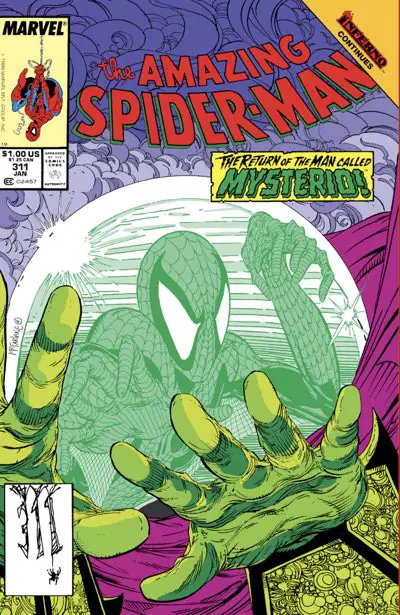
Artist: Todd McFarlane
Colors: Bob Sharen & Evelyn Stein
Letterer: Rick Parker
Publication Date: September 13, 1988
Hell Comes a Knockin’
This issue crosses over with the “Inferno” event. For those of you who weren’t around at the time for that X-Men crossover, New York City had been taken control of by hellish demons, and lots of things around the city came alive that shouldn’t otherwise have done so.
For those of you who weren’t around for the original, the X-Office recently recycled it for another event. If there’s one thing that the X-Office does well, it’s recycling Chris Claremont-era X-Men stories. Repeatedly.
This is the first of three issues of “The Amazing Spider-Man” that tie into the event, and they only get more bizarre. Just wait until we get to issue #313…
Check Out Spider-Man
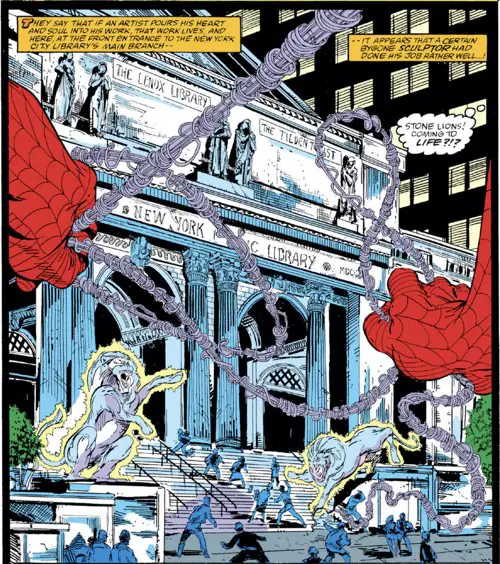
The issue starts at the New York Public Library. The lions in front have come to life and are attacking innocent bystanders. This is all part of the Inferno event, where random craziness is happening throughout the city.
For those of you who aren’t familiar with them, yes, those lions really do exist. You may have seen them in one of a very long list of movies.
Their names are Patience and Fortitude. They’ve been there for as long as the library has been there, over a hundred years now.

Chiseled into the facade behind them in McFarlane’s art are “The Tilden Trust” and “The Lenox Library“. The former is where the library got its initial funding. The latter is a predecessor to the main Public Library, and a major contributor of materials to the library at its start. Just out of view to the left is where it is chiseled, “The Astor Library.” That’s another library in the city that contributed to the NYPL. As you might imagine, it was funded by John Jacob Astor, who would later died on The Titanic.
At the beginning of the coronavirus pandemic, the lions out front were adorned with face masks. And, in the quintessential New York City story, they kept getting stolen or vandalized. You’d think Spider-Man would ramp up his patrol in that neighborhood.
A similar thing happened to statues of lions outside the Art Institue in Chicago, which is the kind of thing that happens in a city after you’ve driven The Savage Dragon out of the country…
The Building That Walks!
Shortly after that harrowing incident, Spider-Man stops a mugging a couple of blocks over, only for the building that he’s resting on to come alive like a golem, and attack.
Hot on the heels of the lions’ attack, it seems natural to assume this is “more of the same.” These incidents have to be related, right?
Spider-Man thinks so, too, but that’s only because he’s not the smart reader who has been given every clue to know that it’s Mysterio behind this one. David Michelinie’s script hammers that home. The people being mugged don’t act naturally. They act like hammy Broadway rejects, including all of the subtlety and none of the singing skill.
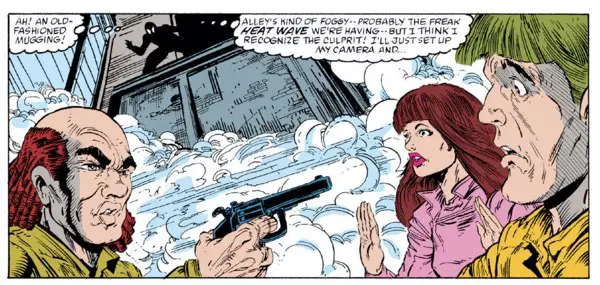
Also, there’s a noticeable amount of smoke in the area before things break down and come alive. You know there’s smoke there because not only does Todd McFarlane draw it, but Spider-Man thinks it, pointing out the obvious to the reader.
You, dear reader, have already seen the cover and know that Mysterio is in this issue. You’ve caught on pretty quickly to something that seems so obvious to you that Spider-Man appears stupid in this issue.
It’s obviously Mysterio setting you up, Spider-Man! Run away!
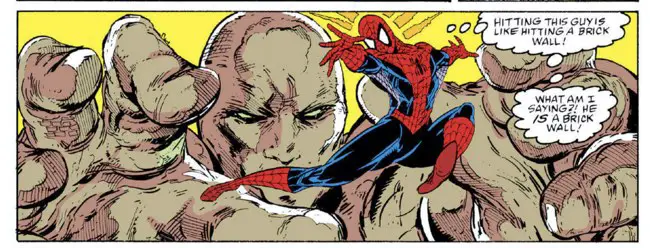
And then the building golem kills the mugging victim in front of Spider-Man. It’s devastating to the red-and-blue arachnid. For the readers, we’re wondering when the smoke will fade out and Mysterio will be revealed. That doesn’t happen, though. Mysterio’s plan, as we’ll learn later, is to trick Spider-Man into being too wracked with guilt to properly defend the city.
That’s… an angle.
It kind of works, too. We get an issue filled with Peter being upset and moody until a pep talk from Mary Jane cheers him up and makes him realize his worth and that the death of that man wasn’t his fault and he should honor that legacy by continuing to fight crime.
After that, he realizes it’s Mysterio and goes after him.
He defeats Mysterio because he’s a scientist. Peter realizes that Mysterio needs a big power source for the illusions he’s conjuring, and so he punches out a circuit box to disrupt the power. Pretty smart. (Can’t beat the time he beat a villain with science and popcorn butter, but that was in Erik Larsen’s run. It was another Michelinie script, though.)
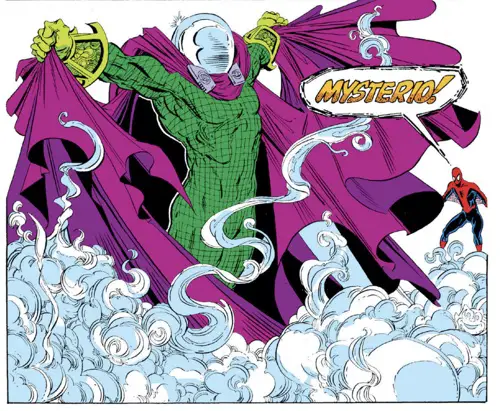
This is where I’m of two minds with this issue. First, Michelinie doesn’t take the cheap way out. Peter has to deal with the guilt he feels over an event that didn’t really happen but was real to him. He has to work through his feeling and, with the help of his wife, come to terms with what happened and to learn a lesson about heroism.
On the other hand, we could all see early on that this was a lie and it didn’t really happen and that Peter was going through all of this for nothing. And it stretches credulity a bit to have Mary Jane convince him so quickly with one speech.
He essentially went through an entire character arc in a handful of pages, but for no reason.
I’ve mentioned this before, but it bears repeating in this case: This story would be an easy six-parter today, hiding Mysterio’s identity until the last issue and Peter dealing with his guilt for that entire run of issues. (The only question is whether he’d withdraw from superheroing or whether he’d go twice as hard and wear himself out over it, leaving a weakened Spider-Man susceptible to Mysterio’s final assault, etc. etc.)
As much as I complain about every story being six issues these days, I think this is a story that would have worked better with more space and a bit more mystery to it. Peter’s arc in this issue feels a little too quick and the rug gets pulled out from under it just as soon as he finishes it.
A French Angle
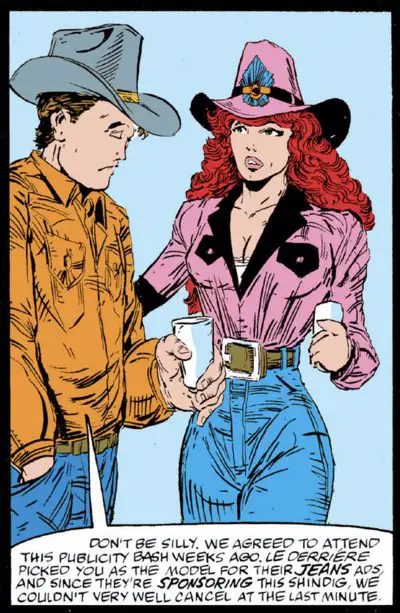
The big turning point of the issue is when Peter accompanies his supermodel wife to a party for Le Derriére jeans, for whom she’s a model. Completely missing the point, McFarlane only draws one derriere in the whole party scene.
Tangent: There’s a restaurant in Paris called “Derriére” that has an interesting animation on its front page. Truly, nothing says fine dining more than looking at a butt through a door’s peep hole.
B Plots
Dr. Swann is back at ESU after proper punishments for buying his high school diploma. He’s lost tenure (which he’ll get back in a few years anyway) and was “stripped of his privileges,” whatever that means. Did they take away his key to the men’s room?
Peter also runs into Curt Connors (a/k/a The Lizard) while he’s there. They trade pleasantries, but it’s obvious that Connors is in the middle of a storyline that’ll come into play in this series in a couple of issues.
McFarlane Art Update
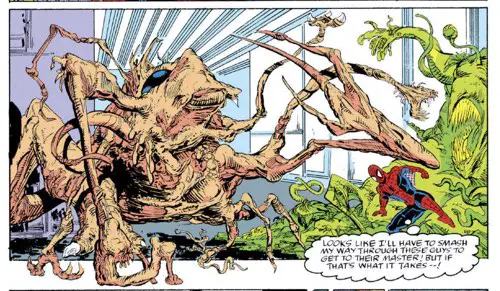
McFarlane gets to draw some of those demons/aliens he seems to enjoy with this issue, disguised as movie props and illusions in Mysterio’s lair. And Mysterio’s caped outfit and low cloud cover puts together all of McFarlane’s strengths, as you can see in the large image earlier in this review.
While his “normal people” art is at times inconsistent or outright awkward, his superhero work is top notch in this issue. The Golem looks awesome, and provides a great bundle of rubble in his final fall. The library lions look great, complete with proper texturing — a smooth concrete shine. You can’t underestimate what a strong craft issue that was in these pre-Photoshop days. It wasn’t as easy as adding a layer over the colors to rough up some textures.
Spider-Man vs. Mysterio at the end makes for a great pair of posed pages, as word balloons cascade around the pair. McFarlane even got to play with the wonky page layouts.
Visually, it’s a strong issue in McFarlane’s development.
Speedlines?
One other thought: When did speed lines become commonplace in North American superhero comics? I seem to recall they became more popular when they were brought over from manga, which happened in the late 1980s, primarily through Art Adams and his artistic descendants like Jim Lee. McFarlane used them an awful lot, sometimes in places where they made no sense to add any action to a panel. Here, they make sense, though:

It’s also of interest that he left white space directly underneath Spider-Man. I wonder if this was done digitally today, would he be more likely to put the speedlines on a layer below the art and just have them color held to gray? Then, you could keep ALL the speed lines, but they wouldn’t fight for attention the way plain black ink lines did on newsprint at this time.
Coloring is by Bob Sharon and Evelyn Stein, though I couldn’t tell you who did what.

Rick Parker had fun with the sound effects in this issue. The best is the building golem falling to the ground with an earth-shattering “BRAKLASH” sound effect.
Looking back at this from a 2022 perspective, it’s a breath of fresh air to see hand-lettered sound effects. I know some artists do them on their own art these days, but they’re still rare.
Felix the Cat Watch
We have two Felix appearances in this issue.
The less obvious of the two comes from the big Mysterio hero shot I showed you above. If you look in the curling clouds of smoke in the bottom right corner, you’ll find a Felix.
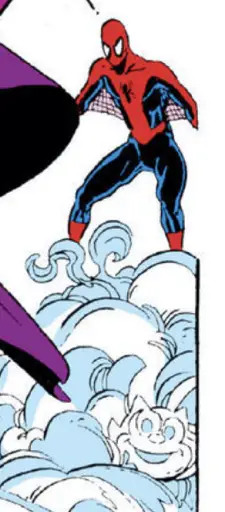
The second one happens on the last page, when Harry Osborn checks on his son, baby Norman:

Isn’t that cute? Also, does it remind you of anything else? Let’s get to that now:
Spawn Watch
Remember when Spawn’s daughter, Cyan, had a Felix the Cat stuffed animal in her crib?
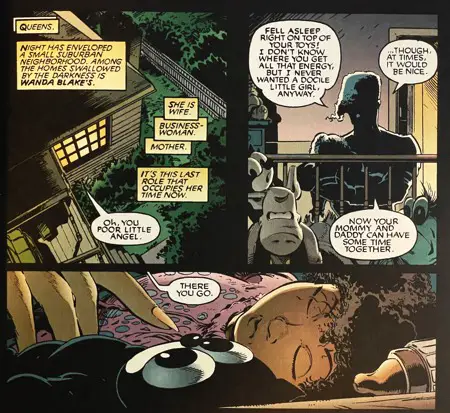
This is from “Spawn” #5. It’s a cute Cerebus in there, too.
Hidden Spider Watch
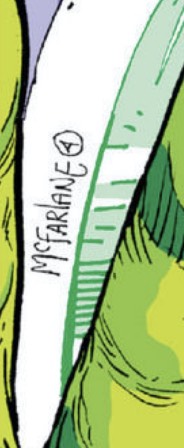
Next to McFarlane’s scroll-less signature on the cover is a circled number 4. That’s there to indicate how many hidden spiders there are on the cover. It’s a pretty big number, but once you find one of them, it’s easy to find them all. He hid them all in the cuffs of Mysterio’s costume. Thankfully, he was smart enough not to hide any in the clouds at the top of the cover where the logo or the corner box might block them.
There are three spiders on the right side of the cover (just below Mysterio’s left hand) and one on the left. I colored them in with white in these details:
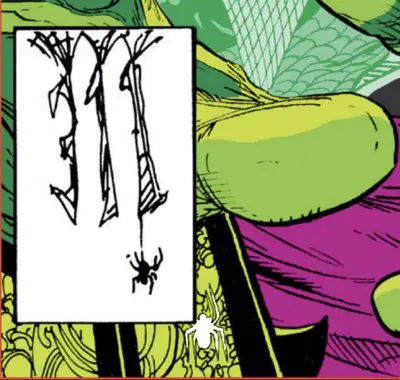
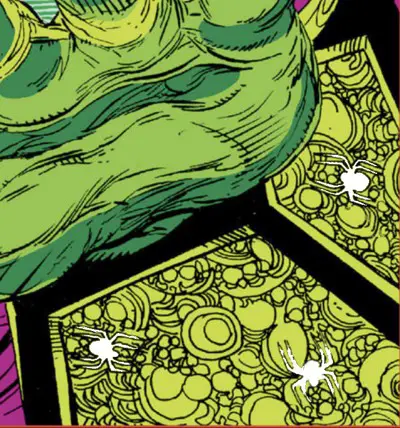
BD Recommendation
If you liked this issue, I have a recommendation for you from the world of les bandes dessinées, or Franco-Belgian comics.

“Game Over” is a collection of mostly single-page gags that first appear in the pages of “Spirou Journal” magazine. Each sequence is a gag where a video game-minded young boy attempts to save the princess and gets one or both of them killed along the way.
Every page ends in someone’s often painful looking and unexpected death.
That death impacts nobody. They all come back to life and live to die again on the next page. Nobody has to feel guilty; they just move on to the next thing.
It’s a very funny series and, as a bonus, it’s entirely silent. For example:
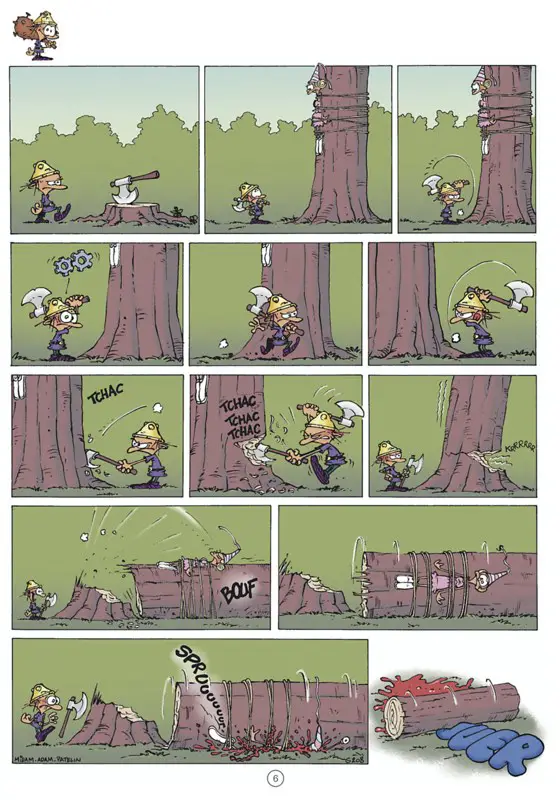
The crazy thing is, there’s no translation of it available — even though it’s silent so it doesn’t need a lot of translation. You need to buy the French edition to get it, but at least it’ll be an easy read.
Some American publisher could make a fortune with this book by marketing it to the right people (video games, D&D folks, etc.). Their production costs would be lower than the average comic since there’s very little translation (some signs) or relettering work necessary.
I did a full review of a book here.
Next issue
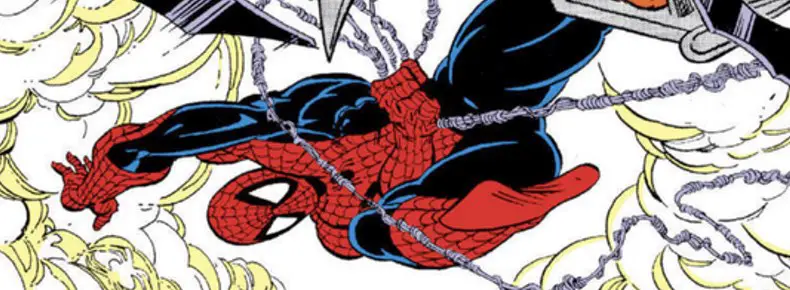
Hobgoblin! Green Goblin! It’s the kind of fight McFarlane was born to draw!

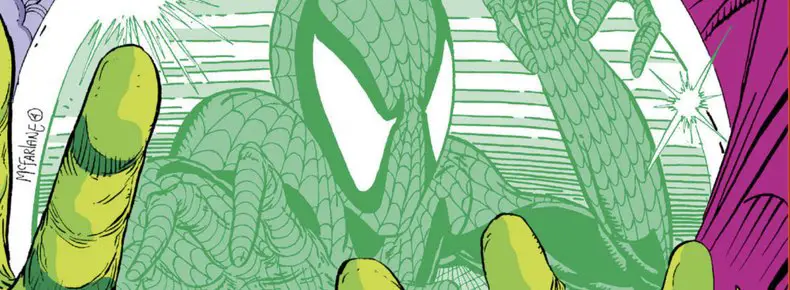
2 Comments